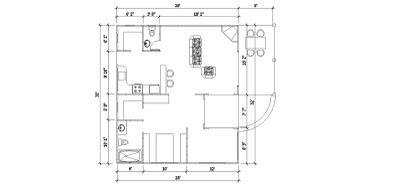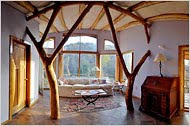From Wikipedia, the free encyclopedia
http://en.wikipedia.org/wiki/Structural_Insulated_PanelsStructural insulated panels (or structural insulating panels), SIPs, are a composite building material. They consist of a sandwich of two layers of structural board with an insulating layer of foam in between. The board can be sheet metal or oriented strand board (OSB) and the foam either expanded polystyrene foam (EPS), extruded polystyrene foam (XPS) or polyurethane foam.
SIPs share the same structural properties as an I-beam or I-column. The rigid insulation core of the SIP performs as a web, while the OSB sheathing exhibits the same properties as the flanges. SIPs replace several components of conventional building such as studs and joists, insulation, vapor barrier and air barrier. As such they can be used for many different applications such as exterior wall, roof, floor and foundation systems.
Contents
* 1 History
* 2 Materials
* 3 Benefits and drawbacks
* 4 Dimensions and characteristics
* 5 Standardization and design
* 6 References
* 7 External links
History
Although foam-core panels gained attention in the 1970s, the idea of using stress skinned panels for construction began in the 1930s. Research and testing of the technology was done primarily by Forest Products Laboratory (FPL) in Madison, Wisconsin as part of U.S. Forest Service's attempts to conserve forest resources. In 1937, a small stressed-skin house was constructed and garnered enough attention to bring in First Lady Eleanor Roosevelt to dedicate the house. In a testament to the durability of such panel structures, it has endured the severe Wisconsin climate and is currently being used by University of Wisconsin–Madison as a day care center. With the success of the stress skinned panels, it was suggested stronger skins could take all of the structural load and eliminate the frame altogether.
Thus in 1947, structural insulated panel development began with corrugated paperboard cores were tested with various skin materials of plywood, tempered hardboard and treated paperboard. The building was dismantled in 1978 and most of the panels retained their original strength with the exception of paperboard which is unsuited to outdoor exposure. Panels consisting of polystyrene core and paper overlaid with plywood skins were used in a building in 1967 and the panels have performed well to the present day.
Materials
SIPs are most commonly made of OSB panels sandwiched around a foam core made of expanded polystyrene (EPS), extruded polystyrene (XPS) or rigid polyurethane foam, but other materials can be used, such as plywood, pressure-treated plywood for below-grade foundation walls, steel, aluminum, cementitious panels, and even exotic materials like stainless steel, fiber-reinforced plastic, and Magnesium Oxide. Some SIPs use fiber-cement or plywood for the panels, and agricultural fiber, such as wheat straw, for the core.
Benefits and drawbacks
The use of SIPs brings many benefits and some drawbacks when compared to a conventional framed building. A well-built home using SIPs will have a tighter building envelope and the walls will have higher insulating properties, which leads to fewer drafts and a decrease in operating costs for maintaining a comfortable interior environment for the occupants. Also, due to the standardized and all-in-one nature of SIPs construction time can be reduced over building a frame home as well as requiring fewer trades for system integration. The panels can be used as floor, wall, and roof, with the use of the panels as floors being of particular benefit when used above an uninsulated space below.
An OSB skinned system structurally outperforms conventional stick framed construction in some cases; primarily in axial load strength. SIPs maintain similar versatility to stick framed houses when incorporating custom designs. Also, since SIPs work as framing, insulation, and exterior sheathing, and can come precut from the factory for the specific job, the exterior building envelope can be built quite quickly.
The EPS insulation is a closed cell insulation whereas fiberglass is an open cell insulation. When tested under laboratory conditions, the SIP, included in a wall, foundation, floor, or roof system, is installed in a steady-state (no air infiltration) environment; systems incorporating fiberglass insulation are not installed in steady-state environments as they require ventilation to remove moisture.
With the exception of structural metals, such as steel, all structural materials creep over time. In the case of SIPs, the creep potential of OSB faced SIPs with EPS or polyurethane foam cores has been studied[1] and creep design recommendations exist[2]. The long-term effects of using unconventional facing and core materials require material specific testing to quantify creep design values.
Many asphalt shingle manufacturers will not warrantee their product over a SIP. Shingles tend to overheat and research has shown a shortened life span [3]
Dimensions and characteristics
In the United States, SIPs tend to come in sizes from 4 feet (1.22 m) to 24 feet (7.32 m) in width. Elsewhere, typical product dimensions are 300, 600, or 1200 mm wide and 2.4, 2.7, and 3 m long, with roof SIPs up to 6 m long. Smaller sections ease transportation and handling, but the use of the largest panel possible will create the best insulated building. At 15−20 kg/m², longer panels can become difficult to work with without the use of a crane to position them, and this is a consideration that must be taken into account due to cost and site limitations. Also of note is that when needed for special circumstances longer spans can often be requested, such as for a long roof span. Typical U.S. height for panels is eight or nine feet (2.44 to 2.75 m). Panels come in widths ranging from 4 to 12 inches thick and a rough cost is $4-$6/sq. ft. in the U.S.[4]
EPS is the most common of the foams used and has an R-value (thermal resistance) of about 4 K·m²/W per 25 mm thickness, which would give the 3.5 inches of foam in a 4.5 inch thick panel an R value of 13.8 (caution: extrapolating R-values over thickness may be imprecise due to non-linear thermal properties of most materials). This at face value appears to be comparable to an R-13 batt of fiberglass, but because in a standard stick frame house there is significantly more wall containing low R value wood that acts as a cold bridge, the thermal performance of the R-13.8 SIP wall will be considerably better.
The air sealing features of SIP homes resulted in the Environmental Protection Agency's Energy Star program to establish an inspection protocol in lieu of the typically required blower door test to assess the home's air leakage. This serves to speed the process and save the builder/homeowner money.
Standardization and design
The International Building Code references APA, Plywood Design Specification 4—Design & Fabrication of Plywood Sandwich Panels[5] for the design of SIPs. This document addressed the basic engineering mechanics of SIP panels but does not provide design properties for the panels provided by any specific manufacturer. In 2007, prescriptive design provisions for OSB faced SIPs were first introduced in the 2006 International Residential Code. These provisions provide guidance on the use of SIPs as walls panels only.
Aside from these non-proprietary standards, the SIP industry has relied heavily on proprietary code evaluation reports. In early 2009, SIPA partnered with NTA, Inc., a product certification agency, to produce the first industry wide code report[6] which is available to all SIPA members who qualify. Unlike previous code reports, the prescriptive provisions provided in the SIPA code report are derived from an engineering design methodology[2] which permits the design professional to consider loading conditions not addressed in the code report.
While the use of SIPs has many potential benefits, caution must be used to ensure that the lack of consideration for such effects does not lead to the creation of ill-designed structures. Use of an experienced architect or designer will minimize this potential issue.
References
1. ^ Taylor, S.B, Manbeck, H.B, Janowiak, J.J, Hiltunum, D.R. "Modeling Structural Insulated Panel (SIP) Flexural Creep Deflection." J. Structrual Engineering, Vol. 123, No. 12, December, 1997.
2. ^ a b NTA IM 14 TIP 01, Engineered Design Guide Using NTA Listing Report Data. NTA, Inc. Nappanee, IN. 3/19/2009, 12 pgs.
3. ^ Structural Insulated Panel Association
4. ^ http://www.greenwall.us/files/GreenWallInc_PriceList.pdf
5. ^ APA. Plywood Design Specification Supplement 4: Design and Fabrication of Plywood Sandwich Panels. Document U814-H. March 1990.
6. ^ SIPA code report information SIPA code report requirements at SIPA web site
* Breyer, Stephen (October 1972), "Copyright: A Rejo…", UCLA Law Review 20: 75–83
External links
* Structural Insulated Panel Association - Industry association for manufacturers of SIPs
* SIPA code report information - SIPA code report requirements.
* NTA SIPA120908-10 - Latest version and current status of the SIPA code report.
* NTA IM 14 TIP 01 Engineered Design Guide for SIPs Using NTA Listing Report Data - Engineering Design guide for SIPs manufactured under the SIPA code report.
* PATH Tech Inventory: Structural Insulated Panels
* PATH Tech Inventory: Fiber-cement Faced Structural Insulated Panels
Retrieved from "http://en.wikipedia.org/wiki/Structural_insulated_panel"
Categories: Building engineering | Building insulation materials | Building materials | Composite materials
...(more)























